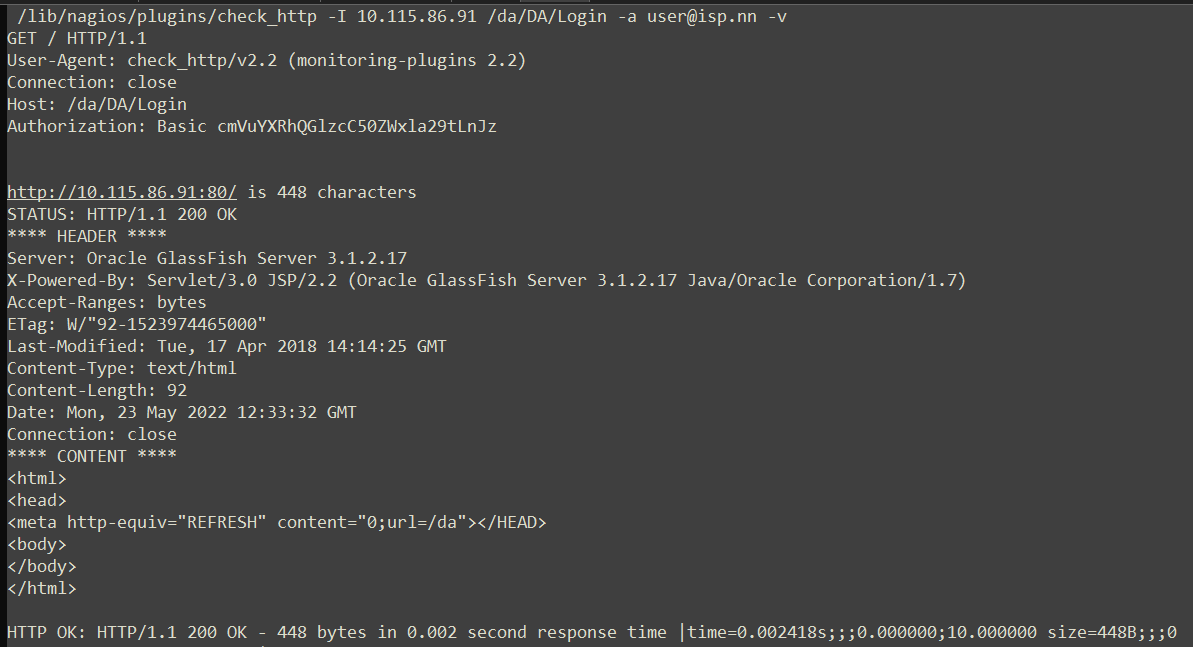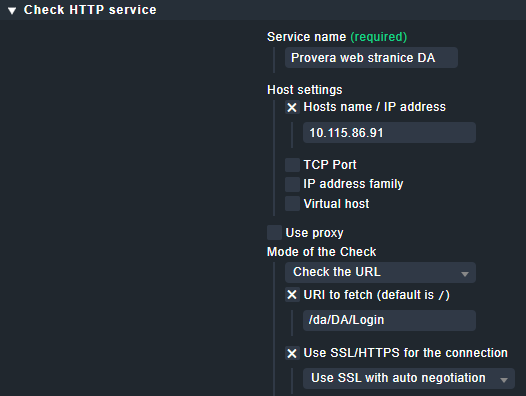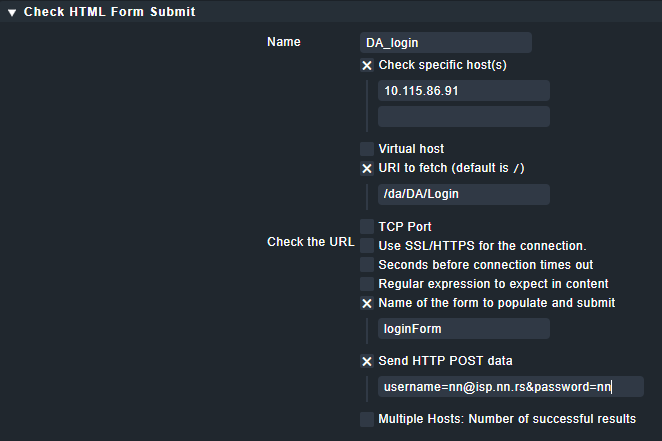Vuk
March 18, 2022, 9:53am
1
CMK version:OMD - Open Monitoring Distribution Version 2.0.0p17.cfe Error message: NO error message
Output of “cmk --debug -vvn hostname”: (If it is a problem with checks or plugins)
Hello,
THE PROBLEM is that if I type the WRONG PWD - I do not get ERROR.
Sounds like a classic RobotMK use case.https://www.robotmk.org/
1 Like
mike1098
March 18, 2022, 11:03am
3
Hello,
I am a bit unsure how you setup this in checkmk. If you use the active check " Check HTTP service" you can fill in the Authorization fields.
I hope that helps
regards
Michael
1 Like
Vuk
May 23, 2022, 7:43am
4
Can you please elaborate?
My understanding is that you would write a test using one of the libraries of the Robot framework (i.e. the Selenium library).
With RobotMK you would the monitor the execution and results of the test. So the actual testing is not done by Checkmk itself, but by the robot.
Take a look at this video: checkmk conference #7: Tech Session - E2E Monitoring - YouTube @simonm can give some additional explanations.
1 Like
simonm
May 23, 2022, 8:12am
6
If your goal is to simply do a basic auth on a HTTPs page, Robotmk would be too heavy imho.@elias.voelker .
Could you show your attempts so far with check_http? As @mike1098 already said, it is a good idea to craft the command on the CLI. The instantaneous feedback form the command (use of -v) is very helpful.
2 Likes
Vuk
May 23, 2022, 1:22pm
7
Here si one “OK” output even without user:pwd pair:
When I set it up in GUI:
It manifests like this:
With much much more data transferred (reported) (448 bytes Vs 6361343 bytes)
simonm
May 23, 2022, 1:45pm
8
-f follow allows the plugin to access the second page.
1 Like
Vuk
May 24, 2022, 6:41am
9
Exactly
The output is now the same size as follows (content stripped for privacy reasons):
GET /da/DA/Login HTTP/1.0
User-Agent: check_http/v2.2 (monitoring-plugins 2.2)
Connection: close
Authorization: Basic cmVuYXRhQGlzcC50ZWxla29tLnJzOmR1cm0xdG9yLjc1
http://10.115.86.91:80/da/DA/Login is 6815569 characters
STATUS: HTTP/1.1 200 OK
**** HEADER ****
Server: Oracle GlassFish Server 3.1.2.17
X-Powered-By: JSP/2.2
Cache-Control: private
Set-Cookie: JSESSIONID=4b88a5892b1e2b51fe1d3d39dee5; Path=/da; HttpOnly
Content-Type: text/html;charset=UTF-8
Date: Tue, 24 May 2022 06:19:36 GMT
Connection: close
CONTENT
(importantant part as I understand it)
<BODY onLoad="document.loginForm.elements['Login.LoginID'].focus();">
<form name="loginForm" method="post" action="../DA/Login;jsessionid=4b88a5892b1e2b51fe1d3d39dee5">
<div id="content">
<div class="appname">
<span><H1>Delegated Administrator</H1></span>
</div>
<div class="inline_alert">
<div class="LogErr">
<table border="0" cellspacing="0" cellpadding="0">
<tr>
<td valign="top">
</td>
</tr>
</table>
</div>
</div>
<div class="form">
<table border="0" cellspacing="0" cellpadding="0">
<tr>
<td>
<span class="LblLev2Txt"><label for="Login.LoginID">Login ID:</label></span>
</td>
<td>
<input type="text" name="Login.LoginID" value="" title="Login ID" class="TxtFld" />
</td>
</tr>
<tr>
<td>
<span class="LblLev2Txt"><label for="Login.Password">Password:</label></span>
</td>
<td>
<input type="password" name="Login.Password" value="" title="Password" class="TxtFld" />
</td>
</tr>
<tr>
<td> </td>
<td>
</td>
</tr>
</table>
</div>
<div class="copyright">
HTTP OK: HTTP/1.1 200 OK - 6815569 bytes in 0.132 second response time |time=0.131753s;;;0.000000;10.000000 size=6815569B;;;0
Although I have not provided password - the result is OK (as with provided pwd).
simonm
May 24, 2022, 8:15am
10
Ah ok, for a login form (instead of basic auth) you better should try the rule “Check HTML Form Submit ”.
2 Likes
Vuk
May 24, 2022, 8:57am
11
Yes! That is the correct check. Do not understand as how I missed it.
However, when I fill the form like this:DA_login
Check specific host(s)10.115.86.91
URI to fetch (default is /)/da/DA/Login
Use SSL/HTTPS for the connection.
Name of the form to populate and submitloginForm usr:pwd
I get the response:
simonm
May 24, 2022, 9:27am
12
I think you don’t fill the form properly. Its not a basic auth with username:password.this thread with an example.
1 Like
Vuk
May 24, 2022, 10:55am
13
Thank you for all the efforts and patience
simonm
May 24, 2022, 11:23am
14
Can you please show the parameters?check_http on the command line. This perhaps better and faster.
1 Like
Vuk
May 24, 2022, 11:45am
15
Here are the parameters:
Could not find the plugin whose name would suggest the check performed.
~$ sudo /opt/omd/versions/2.0.0p17.cfe/lib/nagios/plugins/check_form_submit -I 10.115.86.91 -u /da/DA/Login -f loginForm -q username=nn@isp.nn.rs&password=nn
[5] 466235
~$
But still have problem with form name in the WATO.
EDIT - have put “loginForm” instead of loginForm and it works
simonm
May 25, 2022, 9:50am
16
I would call this a small bug. Because the quotes should not be part of the name…
1 Like
Vuk
May 25, 2022, 11:18am
17
I have hit another problem/dilemma, described here:
CMK version: - 2.0.0p22.cee
OS version:- Ubuntu 20.4
Error message:- not found
**Output of “cmk --debug -vvn hostname”:
OMD[nadzor]:~$ cmk --debug -vvn 10.115.6.75
Checkmk version 2.0.0p22
Try license usage history update.
Trying to acquire lock on /omd/sites/nadzor/var/check_mk/license_usage/next_run
Got lock on /omd/sites/nadzor/var/check_mk/license_usage/next_run
Trying to acquire lock on /omd/sites/nadzor/var/check_mk/license_usage/history.json
Got lock on /omd/sites/nadzor/var/check_mk/…
with no apparent solution.
system
May 25, 2023, 11:19am
18
This topic was automatically closed 365 days after the last reply. New replies are no longer allowed. Contact an admin if you think this should be re-opened.


